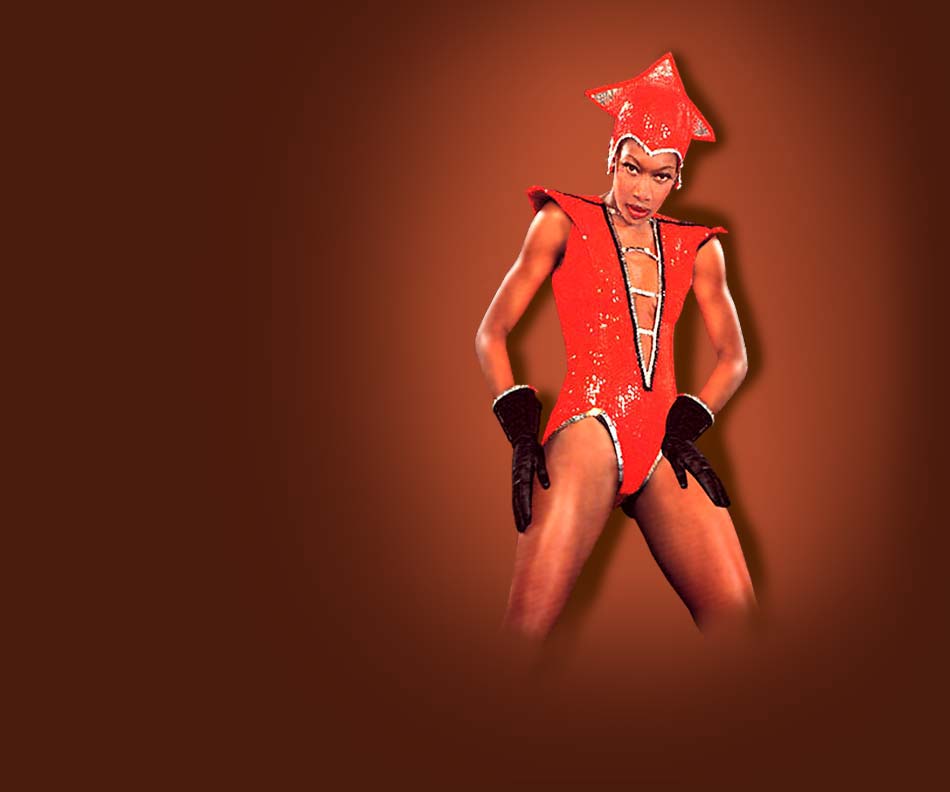The 1970s
saw the birth of Disco - 100% freaking, boogying, hustling,
bumping, bus-stopping, pure disco dancing. It started in the mid-70s
and continued right through, well into the 80s.
The great mother that
gave birth to Disco was Studio 54 in New York where, on the dance
floor, tubes studded with lights steadily rose and descended, Flash
Gordon style, in a dizzying frenzy, while an unearthly sound system
pumped out the steady beat of sizzling dance mixes - often at mind-numbing
decibels.
There was a mood, an
atmosphere, a carefree, no holds barred, non-stop party of seemingly
unaccountable indulgences. It was a magical moment in time... truly
unforgettable... totally wild and wonderful.
One of the biggest groups
to stand out and make their mark was BONEY M. Their
career was comet-like in that they seemed to blast out of nowhere.
Suddenly every discotheque around the world played Boney M and every
TV show wanting to be hip had to have this stunning-looking and fabulous-sounding
foursome from the Caribbean. |
|
|
Their
sound - a mix of reggae, disco, funk, gospel, soul and rock - hit
the charts around the world in a flash. Within moments, it seemed,
everyone knew the Boney M. name and music, and their onward progress
would maintain its star-studded track through our consciousness,
day and night for over ten years, with an endless stream of unforgettable,
sensational hits.
Much
has been written and said about Boney M. over the years. Like many
bands who subsequently drifted apart it seems that their members' individual
memories tend to tarnish or fade shortly after their glorious heyday
of fame, stardom, glitz and glamour. The purpose of this page is to
relate the definitive story as it really happened and recall the essence
of an overnight success which went on to manifest itself with over
40 hit singles, at least 30 albums (many more if we include the regional
variations and ongoing compilations), up to 200 million units sold,
plus numerous live tours and tv appearances spanning three decades.
And so from the day Maizie Willliams,
a classic high-cheekboned, long-legged, (some said "lusciously boney")
fashion model and dancer, was discovered in 1975 by impresario Katja Wolf and
selected as the very first spark of a brand new band, the fire ignited
and the legendary phenomenon of Boney M. was aflame.
So let's start with the Boney M. name - plucked by Frank
Farian straight
from the TV screen in Germany where the popular Australian crime drama
series Boney was
showing. The show itself was based on books by crime writer Arthur
Upfield and the visual
allegory for Farian was perfect: the character Boney (an abbreviation
of Bonaparte) was James Laurenson,
a blacked-up, fair-haired white actor with blue eyes playing the character
of Detective Inspector Napoleon 'Boney' Bonaparte, supposedly part Aboriginal,
part white, carrying out investigations across Australia. And in front
of the screen was Farian, a white man singing what sounded like a black
song with a rich black voice, rather embarrassed by the fact that he
was really a white man in vocal disguise! We are perhaps fortunate he
never considered stretching to the lengths of his tv inspiration but
instead used his better judgment to breathe life into a band that properly
reflected his sound and truly became the personification of his vast
talent. As for the "M." -
we're not sure - any suggestions you send us will be investigated!
Maizie's own story had begun on the tiny and remote, oval shaped Lesser
Antilles Caribbean island of Montserrat where
she and her five siblings were born under the shadow of one of the many
smoking giants in that island chain, commonly named Mount Soufriere.
Fortuitously she and her family left for Europe several decades before
the smoke would turn to lava and ash and destroy their home, previously
one of the most beautiful places in the world. Maizie finished school
in Birmingham, England, went on to study drama, funded by some part-time
modelling and, typical of her modesty, was surprised to win the title
of Miss Black & Beautiful in
a Brighton beauty contest. This inspired the name of her first band,
The Black Beautiful People,
and the title also opened several modestly lucrative doors to the modelling
world. While on assignment at Modewoche (Fashion
Week) in the German town of Hanover she
was approached in a restaurant and asked through an interpreter if she
would dance to a new record. Suspicious enough to refuse but even more
curious to know if this was for real Maizie little knew that her fabulous
career was about to take off. Fortunately for us her hesitation turned
into acceptance, and with her massive talent and stunning good looks
firmly on board the story of one of the world's most successful bands
tentatively began.
Maizie Williams is not only the longest surviving member of the original
Boney M. band but, along with Frank Farian, probably the most influential
in deciding the long term line-up since it was she who vetted the subsequent
members to make sure they would all share a certain chemistry. The initial
line-up had been without question a visual front for a record that was
already a radio hit, while the follow-up combo was selected more for
its broader talent and potential longevity. Maizie Williams, and two
others she remembers only as Nathalie and
Mike,
were briefly recruited to dance to Frank Farian's hit: Baby
Do You Wanna Bump,
for Dutch TV - a song sung entirely by Farian himself at that point.
The first real band was then put in place for the follow-up, the other
original members leaving largely through lack of faith in the project.
Maizie and Frank approved and recruited in turn Marcia
Barrett, Bobby
Farrell and finally
Liz Mitchell.
Together they went on to establish Boney M. as a closely dependent and
indefatigable recording and performing entity in which they all, to different
degrees, performed, sang, danced and generally contributed to their greatest
ability.
Since it's become a matter of debate in more recent times as to how much
each member contributed to the band we can address that here. Quite simply
throughout their partnership they all sang, danced and performed live,
while studio recordings were subsequently mixed by Frank Farian, in a
huge part to include his own vocals, and although we can all read the
written credits the simple truth was that only Farian really knew who
he'd put into the final mix of some of the tracks. Years later it's harder
for any individual to remember accurately the parts left on record as
they all sang (without Farian on stage) on their live tours. However
it's no secret that although she sang in the studio Maizie's less dominant
voice appears to have been mostly excluded from many of the recordings,
with the exception of some backing vocals, for reasons only the producer
knew at the time. Fortunately we can now hear the distinctive quality
of Maizie's dulcet tones in her brand new recording released this year
and trailed here on Maizie's site.
Nevertheless there's no doubting that what their audiences bought into
was a four-piece band with a unique combined stage presence and some
fabulous tunes written and adapted by the great creative force of Frank
Farian behind the scenes. And when the public bought the singles and
albums they bought the whole visual and acoustic package in its entirety
and with all its exuberance. Right from their first real tour in 1977
the four stars sang and danced to sell-out audiences from Wembley to
Moscow, winning literally hundreds of silver, gold and platinum discs
and were officially awarded Most Successful Act
of 1978 in
the UK.
The real break had come from a tv appearance on Germany's Musikladen which
sent Daddy Cool and the album Take
The Heat off Me flying off the shelves with
similar repercussions across Europe after their debut appearance on the UK's
Top Of The Pops, leading to worldwide exposure and
their first major success. Over the next two years Boney M were one of the hottest
music and performance properties, regularly breaking records for sales and chart
positions, culminating in the pinnacle of success with three consecutive albums
reaching #1 in the highest selling European territories. See Discography.
A series of live tours, often a year long, ensued - again the band was breaking
records: breaking down international barriers and taboos with sell-out concerts
in Moscow, right across Africa,
the Middle and Far
East, Canada and South
America, and with shows and costumes getting more flamboyant with
every successive album. Between 1976 and 1979 Boney M. even statistically
outsold their mighty fellow Europeans Abba in
some territories!
By
1981 the band was aflood with rumours of creative frustrations and
a potential split while their record company seemed reluctant to put
their full weight behind the latest album Boonoonoonoos which
featured a more Caribbean sound. Despite this the band continued to
reach new heights everywhere but the UK where the media became somewhat
critical of the change in style and cynical about their material being
provided by Farian rather than being written themselves. At this point Bobby
Farrell was sacked for his unreliability and decided
to go it alone but things were complicated when Christmas
With Boney M., including Little
Drummer Boy, previously released in Europe, recorded and filmed
with Farrell became another million selling album. Reggie
Tsiboe was brought in
to fill the gap but change was not what audiences expected and
in 1985 Bobby was brought back. However with five band members
the chemistry so highly respected by Maizie in the early days
was now ebbing and the long-predicted split became an inevitability.
Ten years of living in each other's pockets, touring, constantly
working and giving the band the best years of their lives had
finally taken its toll. So in 1986 the band had finally broken
up, having earned 18 platinum albums, 15 golds, a staggering 200+ platinum
or gold singles (too many to count!) and at least 150 million units
worldwide. And still, 30 years later, they continue to sell with lowest
estimates of 200 million units at the last count!
Since those glorious days the individual members have produced their
own solo projects while compilations and remixes of old Boney M. product
continue to abound. A brief and promising-sounding regrouping without
Liz Mitchell at the end of the 1980s was brought to a halt by Farian
(who hadn't been involved), and who forbade use of the Boney M. name
while fighting to prevent individual members from using "his" band
name. The result was that with ongoing differences between band members
each has quite validly toured using variations on the name and to this
day that situation persists, while every sympathy is felt for die-hard
fans who may be disappointed by not seeing the original line-up together
on stage. Nevertheless something of the old atmosphere is perpetuated
by each and with their own solo projects being successfully pursued
the main theme of the shows these days is as individual as the band
members themselves.
For Maizie's part her live show now reflects not just the magic of her
days with Boney M. but has the added flavour of new, self-penned Gospel orientated
material, producing an exciting, well-rounded performance appropriate
for the age we live in... the right amount of nostalgia for a decade
gone by, mixed with the place she's at now.
"There's
no place for regrets," says Maizie. "We
all moved on when the band imploded and separately we share a fabulous part
of an amazing time and are happy to enjoy that with the fans who now continue
to give us, as individual performers, their ongoing support. Boney M. was a
massively successful collective made up of people whose own shows
now each convey their own memories of that wonderful time combined
with our own natural progress and diverse directions. Having been there
from the beginning I watched as we all developed. We made a little
bit of music history but the time came when we all had to go our separate
ways. Times change, but the history we all made can't be re-written.
I'm proud to have been an original and influential part of it." Maizie
Williams was with Boney M. from the very beginning and to this day
is still an active performer, now available to recreate that unique
special moment live with her own band of musicians. [See BOOKINGS]
Story
researched and written by Phil Graham |
|



